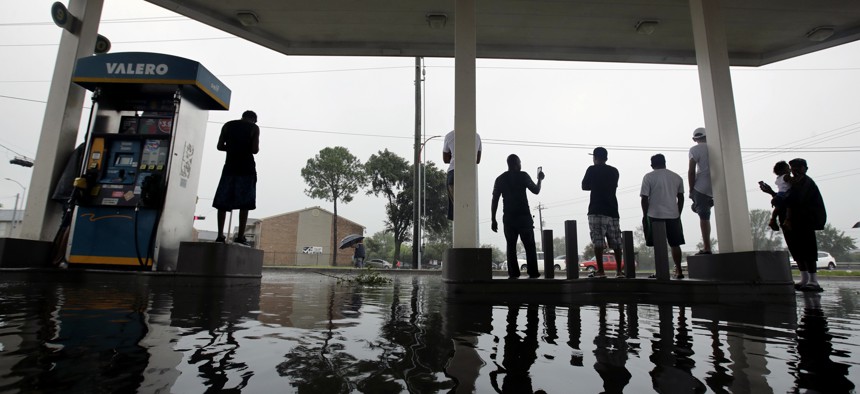Houston Also Had a Disastrous 'Once-in-500-Year' Flood in 2001

People watch heavy rain caused by Harvey from the relative safety of a flooded gas station on Sunday, Aug. 27, 2017, in Houston. (AP Photo/Charlie Riedel)

Connecting state and local government leaders
Why do these floods occur far more frequently than their names would imply?
Tropical storm Harvey, which made landfall in Texas on Friday as a hurricane and was later downgraded, has left at least five people dead, and large parts of Houston under water. Many weather watchers, stunned at the storm’s scope, dubbed it a “once-in-500-year flood.”
It’s a dramatic phrase, but one that’s easily misunderstood. And it makes the likelihood of the kind of flooding Harvey has brought appear more uncommon than it actually is.
In fact, a disastrous “once-in-500-year” flood in the Houston area occurred in 2001. In June that year, Tropical Storm Allison passed through Texas’s Houston and Harris county, leaving 22 dead, 30,000 stranded residents, and $5 billion (.pdf) in damage. “Neither historical data nor weather forecasts could adequately predict this extraordinary storm that, before leaving Texas, would dump as much as 80 percent of the area’s average annual rainfall over some Houston and Harris County neighborhoods,” wrote the Harris County Flood Control District (pdf).
Allison and Harvey aren’t the only storms to receive these centennial honors. Media dubbed Hurricane Katrina a “100-year-storm” when it swept New Orleans in 2005. It did the same for Hurricane Sandy, which hit New York City in 2012. Parts of Texas’s floods of April 2016 were also categorized as 500-year (or even more unlikely) events.
Why do these floods occur far more frequently than their names would imply? The “100-year-flood,” and “500-year-flood” terminology obscures a simple statistical estimate. The lexicon developed as shorthand after the US federal government was drafting the National Flood Insurance Program and came up with “annual exceedance probability” (AEP), which uses historical data to offer an idea of the likelihood of a flood of a particular scale in any year. A 1% AEP flood—also known as a 100-year flood—is a flood of a magnitude that has a 1% chance of occurring in any given year in a given place.
Texas, meanwhile, remains flood central, in large part because of its location on the Gulf of Mexico. The state has seen 59 hurricane strikesfrom hurricanes between 1851 and 2004, second only to Florida (110), and ahead of neighbor Louisiana (49) and North Carolina (46). The longest stretch it endured without any such storms lasted about 10 years, between October 1989 and August 1999. And while Harvey is poised for “record rainfall,” of 50 inches in some spots, that will just barely exceed the benchmarks set by Tropical Storm Claudette, which hit Texas in 1979, and Hurricane Amelia, which hit Texas just one year earlier. Harvey, devastating as it is, is just one of several 100- or 500-year events Texas endures regularly.
Josh Horwitz is a correspondent for Quartz, where this article was originally published.

NEXT STORY: Dallas, Other Cities Playing a Familiar Disaster-Relief Role




